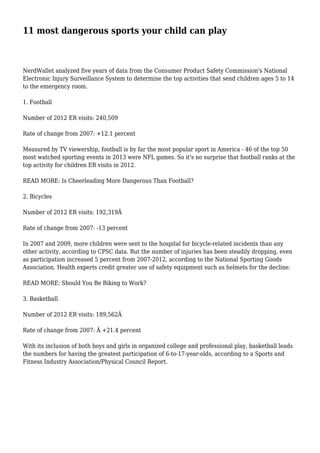
11 most dangerous sports your child can play
- 1. 11 most dangerous sports your child can play NerdWallet analyzed five years of data from the Consumer Product Safety Commission's National Electronic Injury Surveillance System to determine the top activities that send children ages 5 to 14 to the emergency room. 1. Football Number of 2012 ER visits: 240,509 Rate of change from 2007: +12.1 percent Measured by TV viewership, football is by far the most popular sport in America - 46 of the top 50 most watched sporting events in 2013 were NFL games. So it's no surprise that football ranks at the top activity for children ER visits in 2012. READ MORE: Is Cheerleading More Dangerous Than Football? 2. Bicycles Number of 2012 ER visits: 192,319Â Rate of change from 2007: -13 percent In 2007 and 2009, more children were sent to the hospital for bicycle-related incidents than any other activity, according to CPSC data. But the number of injuries has been steadily dropping, even as participation increased 5 percent from 2007-2012, according to the National Sporting Goods Association. Health experts credit greater use of safety equipment such as helmets for the decline. READ MORE: Should You Be Biking to Work? 3. Basketball Number of 2012 ER visits: 189,562Â Rate of change from 2007: Â +21.4 percent With its inclusion of both boys and girls in organized college and professional play, basketball leads the numbers for having the greatest participation of 6-to-17-year-olds, according to a Sports and Fitness Industry Association/Physical Council Report.
- 2. 4. Baseball/Softball Number of 2012 ER visits: 112,577Â Rate of change from 2007: +3.1 percent According to a 2012 analysis by ESPN, youth baseball is the most popular organized sport for little athletes ages 6 to 8 and remains the second most popular organized sport behind basketball until high school. 5. Soccer Number of 2012 ER visits: 99,068Â Rate of change from 2007: Â +19.8 percent With the World Cup this month, soccer has been put in the (albeit rare) national U.S. media spotlight. But the popularity of the sport has been feeding participation - and the number of injuries, experts say. "More total hours played of a sport increases absolute injury numbers," said Dr. Russell Petrie, a sports medicine orthopedist from Hoag Orthopedic Institute in Irvine, California. 6. Swimming Number of 2012 ER visits: 79,751Â Rate of change from 2007: +28.2 percent According to the CDC, 36 percent of children between the ages of 7 and 17 go swimming at least six times a year, so a 28.2 percent increase in swimming-related injuries should raise alarm bells. 7. Trampoline Number of 2012 ER visits: 62,569Â Rate of change from 2007: Â -13.8 percent Manufacturers now advise users to only allow one child at a time on a trampoline - 75 percent of all injuries occur when there are two or more jumpers. Enclosures to prevent errant bounces onto the
- 3. ground are now standard. And injuries, which peaked at 110,000 ER visits in 2004, have been on a long downward slide. 8. Skating (non-inline) Number of 2012 ER visits: 42,117Â Rate of change from 2007: -6.9 percent The number of roller skaters has dropped to 13.35 million in 2012 from 19.74 million in 2007, according to website Statistica. Ice skating enjoys perennial popularity thanks to its Olympic and professional skating status, as well as its close cousin ice hockey (see No. 10 below). READ MORE: The Surprising Financial and Health Benefits of Walking 9. Skateboard Number of 2012 ER visits: 39,146Â Rate of change from 2007: -44.4 percent The number of people who skateboard has dropped by 47 percent from 2007 to 2012, according to the National Sporting Goods Association. While that drop worries aficionados and skateboard manufacturers, it has brought a bright spot to the ER doctors and parents - the number of ER visits for skateboard-related injuries dropped 44 percent during the same time period. 10. Hockey Number of 2012 ER visits: 21,145Â Rate of change from 2007: Â +14 percent Hockey is now the sixth most popular sport in the U.S., according to a recent Harris Poll, up from No. 11 in 1985. Youth participation has grown from 200,000 in 2000 to more than 350,000 in 2012, according to the American Academy of Pediatrics. Especially controversial is at what age children should be allowed to "check" opponents - full body defensive blocks of whomever controls the puck. USA Hockey allows checking starting at the 11-to-12-year-old Pee Wee League, but a recent AAP
- 4. study recommends raising the age to 15. 11. Volleyball Number of 2012 ER visits: 20,490Â Rate of change from 2007: +22.1 percent Participation in volleyball in high school has grown to more than 470,500 students from just under 445,000 in the 2007-08 school year - an increase of 5.8 percent, according to the National Federation of High School Associations. Volleyball's growth is fueled by popularity among girls. Kevin Voigt writes for NerdWallet Health, a website that empowers consumers to find high quality, affordable health care and insurance.